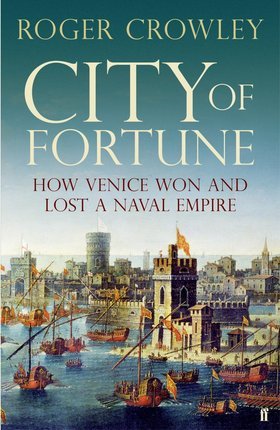The struggle by the city-states of Italy to dominate the medieval Mediterranean trade routes was a ruthless one and Venice was the key player. The famous account of Venetian merchants stealing the body of St Mark from Alexandria in 828, whether the stuff of legend or not, shows that Venetian merchants were trading in the East as early as the ninth century. Roger Crowley begins his own lively study of Venice’s fortunes in the eleventh century, but he is soon off to his first great set-piece, the notorious Fourth Crusade of 1204.

The crusaders who had answered the call from Pope Innocent III to free the Holy Land had booked a fleet of Venetian galleys to take them there. Crowley tells the tale of what actually happened when they could not pay up: a free-booting enterprise which ends with the sacking of Constantinople, the greatest Christian city of the Mediterranean, by the crusaders. Whether or not this shocking diversion was manipulated by the aged, and blind, Venetian doge, Enrico Dandolo, who led the expedition, the Venetians were quick to ensure that harbours and trading posts of the shattered Byzantine Empire along the routes back to Venice now became theirs. Booty, including the fine copper horses that were placed on St Mark’s and a mass of sacred relics, looted from the heretical Greeks, flowed back into Europe.
Crowley tells this story with great panache. Then he turns his attention to the problems of control of the Stato da Mar, the Venetian Empire, that followed. Crete was vital as a staging post but with its people tenaciously clinging to their Greek Orthodoxy and resentful of the Venetian settlers, there were continual revolts. The Venetians never pretended that they ruled in the interests of their subjects and suppression was harsh, especially when a revolt of 1363 was crushed with the help of mercenaries. Everyone in Venice knew how vital the Cretan harbours were to their prosperity and the city exploded with flamboyant celebrations in St Mark’s Square as soon as the galleys brought home the news of a successful repression.
The fourteenth century also saw the culmination of centuries of struggle with Genoa. The Genoese had been masters of the sea almost as early as the Venetians. Yet Venice’s success in the Fourth Crusade had edged them out and they were determined on revenge. The wars were debilitating and in 1379 nearly ended in utter disaster for Venice when the Genoese captured Chioggia, just a few miles south of the city. Venice was isolated and the Genoese stranglehold began to suffocate her. The charismatic Venetian naval commander, Vettor Pisani, who had been brought back and imprisoned in the city after an earlier defeat, was the Venetians’ last hope and by popular acclaim he was released. Crowley regales us with the story of how Pisani, with a revitalised fleet behind him, finally out-manoeuvred the resilient enemy.
After these dramatic events, Crowley pauses to draw breath and there are more reflective chapters on the Venetian state and empire in the fifteenth century, the intricacies of diplomacy and the management of the fleets, with the lucrative pilgrimage trade to the East among the sources of new income. Yet by the fifteenth century there is a new threat after the Ottoman empire begins its inexorable expansion over the eastern Mediterranean. Crowley makes another set-piece of the fall of Negroponte, the island of Euboea, in 1470, and then there is the devastating loss of nerve by the Venetians at the battle of Zonchio in the Ionian Sea in August 1499, when Venice failed to engage the Ottoman fleet and so lost the initiative for ever.
This is a fast-paced and enjoyable book. Perhaps Crowley concentrates too much on the big moments when all seemed lost or won and the blood flows freely—but read City of Fortune and you will understand with what trepidation the arrival of a galley from the East was greeted. Did it bear news of a defeat that could put all in jeopardy or of another conquest which would keep the fabulous riches of the Orient flooding into the city? Each was equally possible and Crowley vividly reminds us that the survival of Venice was as precarious in the fourteenth century as it is today.
Reviewed by Charles Freeman, historical consultant to the Blue Guides and author of Sites of Antiquity: 50 Sites that Explain the Classical World. His Holy Bones Holy Dust, a study of the medieval cult of relics, is reviewed here.






